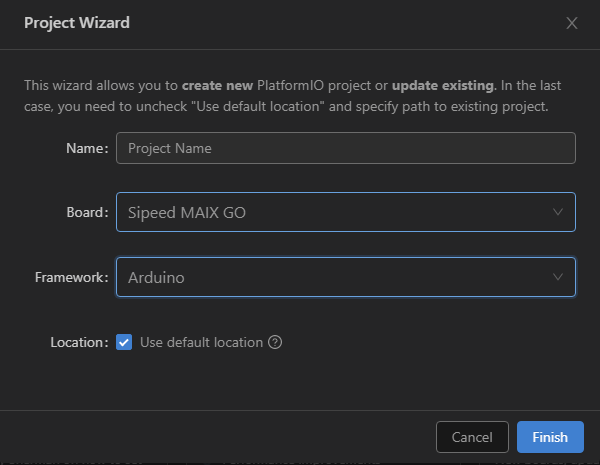はじめに
M5StickVの基本はMicroPythonのMaixPyの利用です。MicroPythonを使ってM5StickV(K210)で簡単にAIを体験、利用することができます。
ただ、限られたリソースでハードウェアを使いこなそうとすると、C++を使いたい場合があるかもしれません。M5StickVはMaixCubeとは兄弟みたいなものなのでMaixシリーズ同様にArduino/Maixduino開発環境が使ってみましょう。
Maixduino
MaixCubeでも、Maixシリーズ用のArduino開発環境Maixduinoを使ってみましょう。
PlatformIOを使い、「+ New Project」新規プロジェクトを作成を選択し、
ボードに「Sipeed MAIX GO」を選択すれば、M5StickVでもある程度利用できます。
サンプルアプリ
-
カメラは、OV7740というセンサーが使われていて、MaixCubeと同じです
-
SPIは、Maixシリーズが8bitのインターフェースに対して、M5StickVでは1bitのシリアルです。Maixduino標準のSipeed_ST7789のライブラリーではなくTFT_eSPIを使用してみました
# include <Arduino.h>
# include <TFT_eSPI.h>
# include <Maixduino_OV7740.h>
# include <Wire.h>
# ifdef M5STICKV
# define AXP192_ADDR 0x34
# define PIN_SDA 29
# define PIN_SCL 28
# endif
TFT_eSPI lcd;
//OV7740 supports YUV only
Maixduino_OV7740 camera(FRAMESIZE_QVGA, PIXFORMAT_YUV422);
bool axp192_init() {
Serial.printf("AXP192 init.\n");
sysctl_set_power_mode(SYSCTL_POWER_BANK3,SYSCTL_POWER_V33);
Wire.begin((uint8_t) PIN_SDA, (uint8_t) PIN_SCL, 400000);
Wire.beginTransmission(AXP192_ADDR);
int err = Wire.endTransmission();
if (err) {
Serial.printf("Power management ic not found.\n");
return false;
}
Serial.printf("AXP192 found.\n");
// Clear the interrupts
Wire.beginTransmission(AXP192_ADDR);
Wire.write(0x46);
Wire.write(0xFF);
Wire.endTransmission();
Wire.beginTransmission(AXP192_ADDR);
Wire.write(0x23);
Wire.write(0x08); //K210_VCore(DCDC2) set to 0.9V
Wire.endTransmission();
Wire.beginTransmission(AXP192_ADDR);
Wire.write(0x33);
Wire.write(0xC1); //190mA Charging Current
Wire.endTransmission();
Wire.beginTransmission(AXP192_ADDR);
Wire.write(0x36);
Wire.write(0x6C); //4s shutdown
Wire.endTransmission();
Wire.beginTransmission(AXP192_ADDR);
Wire.write(0x91);
Wire.write(0xF0); //LCD Backlight: GPIO0 3.3V
Wire.endTransmission();
Wire.beginTransmission(AXP192_ADDR);
Wire.write(0x90);
Wire.write(0x02); //GPIO LDO mode
Wire.endTransmission();
Wire.beginTransmission(AXP192_ADDR);
Wire.write(0x28);
Wire.write(0xF0); //VDD2.8V net: LDO2 3.3V, VDD 1.5V net: LDO3 1.8V
Wire.endTransmission();
Wire.beginTransmission(AXP192_ADDR);
Wire.write(0x27);
Wire.write(0x2C); //VDD1.8V net: DC-DC3 1.8V
Wire.endTransmission();
Wire.beginTransmission(AXP192_ADDR);
Wire.write(0x12);
Wire.write(0xFF); //open all power and EXTEN
Wire.endTransmission();
Wire.beginTransmission(AXP192_ADDR);
Wire.write(0x23);
Wire.write(0x08); //VDD 0.9v net: DC-DC2 0.9V
Wire.endTransmission();
Wire.beginTransmission(AXP192_ADDR);
Wire.write(0x31);
Wire.write(0x03); //Cutoff voltage 3.2V
Wire.endTransmission();
Wire.beginTransmission(AXP192_ADDR);
Wire.write(0x39);
Wire.write(0xFC); //Turnoff Temp Protect (Sensor not exist!)
Wire.endTransmission();
fpioa_set_function(23, (fpioa_function_t)(FUNC_GPIOHS0 + 26));
gpiohs_set_drive_mode(26, GPIO_DM_OUTPUT);
gpiohs_set_pin(26, GPIO_PV_HIGH); //Disable VBUS As Input, BAT->5V Boost->VBUS->Charing Cycle
msleep(20);
return true;
}
void setup() {
Serial.begin(115200);
axp192_init();
/* LCD init */
lcd.begin();
lcd.setRotation(1);
/* DVP init */
Serial.printf("DVP init\n");
if (!camera.begin()) {
Serial.printf("camera init fail\n");
while (true) {}
} else {
Serial.printf("camera init success\n");
}
camera.run(true);
}
void loop() {
uint8_t *img = camera.snapshot();
if (img == nullptr || img == 0) {
Serial.printf("snap fail\n");
return;
}
lcd.pushImage(0, 0, camera.width(), camera.height(), (uint16_t*)img);
}
Ktool
Ktoolでフラッシュメモリに書き込む場合の、platformio.iniの設定はMaix-Goなどと同じです。
; PlatformIO Project Configuration File
;
; Build options: build flags, source filter
; Upload options: custom upload port, speed and extra flags
; Library options: dependencies, extra library storages
; Advanced options: extra scripting
;
; Please visit documentation for the other options and examples
; https://docs.platformio.org/page/projectconf.html
[env:m5stickv]
platform = kendryte210
board = sipeed-maix-go
framework = arduino
monitor_speed = 115200
upload_flags =
-a
0
-B
goE
upload_command = $PROJECT_PACKAGES_DIR/ktool/ktool.py $UPLOAD_FLAGS $SOURCE
まとめ
M5StickVでもArduino互換の開発環境が準備できました。
デフォルトのファームウェアはv0.4.0-52-g3b8c18b84-dirtyというものが入っていました。元に戻す場合のご参考。
MicroPython v0.4.0-52-g3b8c18b84-dirty on 2019-10-21; M5Stick-V with Kendryte K210

